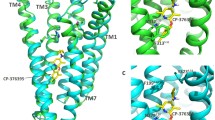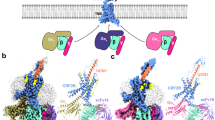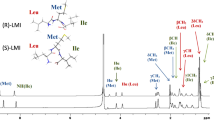Abstract
The 41 amino acid neuropeptide, corticotropin-releasing factor (CRF) and its associated receptors CRF1-R and CRF2-R have been targeted for treating stress related disorders. Both CRF1-R and CRF2-R belong to the class B G-protein coupled receptors for which little information is known regarding the small molecule antagonist binding characteristics. However, it has been shown recently that different non-peptide allosteric ligands stabilize different receptor conformations for CRF1-R and hence an understanding of the ligand induced receptor conformational changes is important in the pharmacology of ligand binding. In this study, we modeled the receptor and identified the binding sites of representative small molecule allosteric antagonists for CRF1-R. The predicted binding sites of the investigated compounds are located within the transmembrane (TM) domain encompassing TM helices 3, 5 and 6. The docked compounds show strong interactions with H228 on TM3 and M305 on TM5 that have also been implicated in the binding by site directed mutation studies. H228 forms a hydrogen bond of varied strengths with all the antagonists in this study and this is in agreement with the decreased binding affinity of several compounds with H228F mutation. Also mutating M305 to Ile showed a sharp decrease in the calculated binding energy whereas the binding energy loss on M305 to Leu was less significant. These results are in qualitative agreement with the decrease in binding affinities observed experimentally. We further predicted the conformational changes in CRF1-R induced by the allosteric antagonist NBI-27914. Movement of TM helices 3 and 5 are dominant and generates three degenerate conformational states two of which are separated by an energy barrier from the third, when bound to NBI-27914. Binding of NBI-27914 was predicted to improve the interaction of the ligand with M305 and also enhanced the aromatic stacking between the ligand and F232 on TM3. A virtual ligand screening of ~13,000 compounds seeded with ~350 CRF1-R specific active antagonists performed on the NBI-27914 stabilized conformation of CRF1-R yielded a 44% increase in enrichment compared to the initially modeled receptor conformation at a 10% cutoff. The NBI-27914 stabilized conformation also shows a high enrichment for high affinity antagonists compared to the weaker ones. Thus, the conformational changes induced by NBI-27914 improved the ligand screening efficiency of the CRF1-R model and demonstrate a generalized application of the method in drug discovery.








Similar content being viewed by others
References
Kehne J, De Lombaert S (2002) Non-peptidic CRF1 receptor antagonists for the treatment of anxiety, depression and stress disorders. Curr Drug Targets CNS Neurol Disord 1:467–493
Holsboer F (2001) CRHR1 antagonists as novel treatment strategies. CNS Spectr 6:590–594
Smagin GN, Dunn AJ (2000) The role of CRF receptor subtypes in stress-induced behavioural responses. Eur J Pharmacol 405:199–206
Zobel AW, Nickel T, Kunzel HE, Ackl N, Sonntag A, Ising M, Holsboer F (2000) Effects of the high-affinity corticotrophin-releasing hormone receptor 1 antagonist R121919 in major depression: the first 20 patients treated. J Psychiatr Res 34:171–181
Ising M, Zimmermann US, Kunzel HE, Uhr M, Foster AC, Learned-Coughlin SM, Holsboer F, Grigoriadis DE (2007) High-affinity CRF1 receptor antagonist NBI-34041: preclinical and clinical data suggest safety and efficacy in attenuating elevated stress response. Neuropsychopharmacol 32:1941–1949
Martinez V, Tache Y (2006) CRF1 receptors as a therapeutic target for irritable bowel syndrome. Curr Pharm Des 12:4071–4088 and references cited therein
Zorrilla EP, Koob GF (2004) The therapeutic potential of CRF1 antagonists for anxiety. Expert Opin Investig Drugs 13:799–828
Palczewski K, Kumasaka T, Hori T, Behnke CA, Motoshima H, Fox BA, Le TI, Teller DC, Okada T, Stenkamp RE, Yamamoto M, Miyano M (2000) Crystal structure of rhodopsin: a G protein-coupled receptor. Science 289:739–745
Cherezov V, Rosenbaum DM, Hanson MA, Rasmussen SG, Thian FS, Kobilka TS, Choi HJ, Kuhn P, Weis WI, Kobilka BK, Stevens RC (2007) High-resolution crystal structure of an engineered human beta2-adrenergic G protein-coupled receptor. Science 318:1258–1265
Jaakola VP, Griffith MT, Hanson MA, Cherezov V, Chien EY, Lane JR, Ijzerman AP, Stevens RC (2008) The 2.6 Angstrom crystal structure of a human A2A adenosine receptor bound to an antagonist. Science 322:1211–1217
Warne T, Serrano-Vega MJ, Baker JG, Moukhametzianov R, Edwards PC, Henderson R, Leslie AG, Tate CG, Schertler GF (2008) Structure of a beta1-adrenergic G-protein-coupled receptor. Nature 454:486–491
Park JH, Scheerer P, Hofmann KP, Choe HW, Ernst OP (2008) Crystal structure of the ligand-free G-protein-coupled receptor opsin. Nature 454:183–187
Schlyer S, Horuk R (2006) I want a new drug: G-protein-coupled receptors in drug development. Drug Discov Today 11:481–493
Liaw CW, Grigoriadia DE, Lorang MT, De Souza EB, Maki RA (1997) Localization of agonist- and antagonist-binding domains of human corticotropin-releasing factor receptors. Mol Endocrinol 11:2048–2053
Hoare SR, Sullivan SK, Schwarz DA, Ling N, Vale WW, Crowe PD, Grigoriadis DE (2004) Ligand affinity for amino-terminal and juxtamembrane domains of the corticotropin releasing factor type 1 receptor: regulation by G-protein and nonpeptide antagonists. Biochemistry 43:3996–4011
Hoare SRJ, Brown BT, Santos MA, Malany S, Betz SF, Grigoriadis DE (2006) Single amino acid residue determinants of non-peptide antagonist binding to the corticotropin-releasing factor1 (CRF1) receptor. Biochem Pharmacol 72:244–255
Urban JD, Clarke WP, von Zastrow M, Nichols DE, Kobilka B, Weinstein H, Javitch JA, Roth BL, Christopoulos A, Sexton PM, Miller KJ, Spedding M, Mailman RB (2007) Functional selectivity and classical concepts of quantitative pharmacology. J Pharmacol Exp Ther 320:1–13
Kobilka BK, Deupi X (2007) Conformational complexity of G-protein-coupled receptors. Trends Pharmacol Sci 28:397–405
Hoare SRJ, Fleck BA, Gross RS, Crowe PD, Williams JP, Grigoriadis DE (2008) Allosteric ligands for the corticotropin releasing factor type 1 receptor modulate conformational states involved in receptor activation. Mol Pharmacol 73:1371–1380
Heo J, Han SK, Vaidehi N, Wendel J, Kekenes-Huskey P, Goddard WA III (2007) Prediction of the 3D structure of FMRF-amide neuropeptides bound to the mouse MrgC11 GPCR and experimental validation. Chem Biochem 8:1527–1539
Hall S (2005) Development of a structure prediction method for G-Protein coupled receptors. Caltech PhD Thesis http://etd.caltech.edu/etd/available/etd-06012005-235052/
Vaidehi N, Floriano WB, Trabanino R, Hall S, Freddolino P, Choi EJ, Zamanakos G, Goddard WA III (2002) Structure and function prediction for G-Protein coupled receptors. Proc Natl Acad Sci USA 99:12622–12627
Li Y, Zhu F, Vaidehi N, Goddard WA III, Sheinerman F, Reiling S, Morize I, Mu L, Harris K, Ardati A, Laoui A (2007) Prediction of the 3D structure and dynamics of human DP G-protein coupled receptor bound to an agonist and an antagonist. J Am Chem Soc 129:10720–10731
Chen C, Wilcoxen KM, Huang CQ, Xie YF, McCarthy JR, Webb TR, Zhu YF, Saunders J, Liu XJ, Chen TK, Bozigian H, Grigoriadis DE (2004) Design of 2, 5-dimethyl-3-(6-dimethyl-4-methylpyridin-3-yl)-7-dipropylaminopyrazolo[1, 5-a]pyrimidine (NBI 30775/R121919) and structure–activity relationships of a series of potent and orally active corticotropin-releasing factor receptor antagonists. J Med Chem 47:4787–4798
Gross RS, Guo Z, Dyck B, Coon T, Huang CQ, Lowe RF, Marinkovic D, Moorjani M, Nelson J, Zamani-Kord S, Grigoriadis DE, Hoare SRJ, Crowe PD, Bu JH, Haddach M, McCarthy J, Saunders J, Sullivan R, Chen T, Williams JP (2005) Design and synthesis of tricyclic corticotropin-releasing factor-1 antagonists. J Med Chem 48:5780–5793
Bhattacharya S, Hall SE, Vaidehi N (2008) Agonist-induced conformational changes in bovine rhodopsin: insight into activation of G-protein-coupled receptors. J Mol Biol 382:539–555
Bhattacharya S, Hall SE, Li H, Vaidehi N (2008) Ligand-stabilized conformational states of human b2 adrenergic receptor: insight into G-protein-coupled receptor activation. Biophys J 94:2027–2042
Chen C, Dagnino R Jr, De Souza EB, Grigoriadis DE, Huang CQ, Kim KI, Liu Z, Moran T, Webb TR, Whitten JP, Xie YF, McCarthy JR (1996) Design and synthesis of a series of non-peptide high-affinity human corticotropin-releasing factor1 receptor antagonists. J Med Chem 39:4358–4360
Trabanino RJ, Hall SE, Vaidehi N, Floriano WB, Goddard WA III (2004) First principles predictions of the structure and function of G-protein coupled receptors: validation for bovine rhodopsin. Biophys J 86:1904–1921
Schertler GFX (1998) Structure of rhodopsin. Eye 12:504–510
Canutescu AA, Shelenkov AA, Dunbrack RL Jr (2003) A graph-theory algorithm for rapid protein side-chain prediction. Prot Sci 12:2001–2014
Lim KT, Brunett S, Iotov M, McClurg RB, Vaidehi N, Dasgupta S, Taylor S, Goddard WA III (1993) Molecular dynamics for very large systems on massively parallel computers: the MPSim program. J Comput Chem 18:501–521
Mayo SL, Olafson BD, Goddard WA III (1990) DREIDING-a generic force field for molecular simulations. J Phys Chem 94:8897–8909
MacKerell AD, Bashford D, Bellott M, Dunbrack RL, Evanseck JD, Field MJ, Fischer S, Gao J, Guo H, Ha S, Joseph-McCarthy D, Kuchnir I, Kuczera K, Lau FTK, Mattos C, Michnick S, Ngo T, Nguyen DT, Prodhom B, Reiher WE, Roux B, Schlenkrich M, Smith JC, Stote R, Straub J, Watanabe M, Wiorkiewicz-Kuczera J, Yin D, Karplus M (1998) All-atom empirical potential for molecular modeling and dynamics studies of proteins. J Phys Chem B 102:3586–3616
Fiser A, Do RK, Sali A (2000) Modeling of loops in protein structures. Prot Sci 9:1753–1773
Jorgensen WL, Maxwell DS, Tirado-Rives J (1996) Development and testing of the OPLS all-atom force field on conformational energetics and properties of organic liquids. J Am Chem Soc 118:11225–11236
Zamanakos GA (2001) Fast and accurate analytical method for the computation of solvent effects in molecular simulations. PhD thesis Caltech, Pasadena
McDonald IK, Thornton JM (1994) Satisfying hydrogen bonding potential in proteins. J Mol Biol 238:777–793
Hall SE, Roberts K, Vaidehi N (2009) Position of helical kinks in membrane protein crystal structures and the accuracy of computational prediction. J Mol Graph Model 27:944–950
Li J, Edwards PC, Burghammer M, Villa C, Schertler GFX (2004) Structure of bovine rhodopsin in a trigonal crystal form. J Mol Biol 343:1409–1438
Hall SE, Mao A, Nicolaidou V, Finelli M, Wise EL, Nedjai B, Kanjanapangka J, Harirchian P, Chen D, Selchau V, Ribeiro S, Schyler S, Pease JE, Horuk R, Vaidehi N (2009) Elucidation of binding sites of dual antagonists in the human chemokine receptors CCR2 and CCR5. Mol Pharmacol 75:1325–1336
Vaidehi N, Schlyer S, Trabanino RJ, Floriano WB, Abrol R, Sharma S, Kochanny M, Koovakat S, Dunning L, Liang M, Fox JM, de Mendonca FL, Pease JE, Goddard WA III, Horuk R (2006) Predictions of CCR1 chemokine receptor structure and BX 471 antagonist binding followed by experimental validation. J Biol Chem 281:27613–27620
Huang CQ, Wilcoxen K, McCarthy JR, Haddach M, Webb TR, Gu J, Xie Y-F, Grigoriadis DE, Chen C (2003) Synthesis and SAR of 8-arylquinolines as potent corticotrophin-releasing factor1 (CRF1) receptor antagonists. Bioorg Med Chem Lett 13:3375–3379
Huang CQ, Grigoriadis DE, Liu Z, McCarthy JR, Ramphal J, Webb T, Whitten JP, Xie MY, Chen C (2004) Design, synthesis, and SAR of 2-dialkylamino-4-arylpyrimidines as potent and selective corticotrophin-releasing factor1 (CRF1) receptor antagonists. Bioorg Med Chem Lett 14:2083–2086
Assil-Kishawi I, Abou-Samra AB (2002) Sauvagine cross-links to the second extracellular loop of the corticotropin-releasing factor type 1 receptor. J Biol Chem 277:32558–32561
Gkountelias K, Tselios T, Venihaki M, Deraos G, Lazaridis I, Rassouli O, Gravanis A, Liapakis G (2009) Alanine scanning mutagenesis of the second extracellular loop of type 1 corticotropin-releasing factor receptor revealed residues critical for peptide binding. Mol Pharmacol 75:793–800
Beebe X, Darczak D, Vadis-Taber RA, Uchic ME, Scott VE, Jarvis MF, Stewart AO (2008) Discovery and SAR of hydrazide antagonists of the pituitary adenylate cyclase-activating polypeptide (PACAP) receptor type 1 (PAC1-R). Bioorg Med Chem Lett 18:2162–2166
Moore EL, Burgey CS, Paone DV, Shaw AW, Tang YS, Kane SA, Salvatore CA (2009) Examining the binding properties of MK-0974: A CGRP receptor antagonist for the acute treatment of migraine. Mol Cell Pharmacol 602:250–254
Kodra JT, Jorgensen AS, Andersen B, Behrens C, Brand CL, Christensen IT, Guldbrandt M, Jeppesen CB, Knudsen LB, Madsen P, Nishimura E, Sams C, Sidelmann UG, Pederson RA, Lynn FC, Lau J (2008) Novel glucagon receptor antagonists with improved selectivity over the glucose-dependent insulinotropic polypeptide receptor. J Med Chem 51:5387–5396
Carter PH et al (2007) Discovery of a small molecule antagonist of the parathyroid hormone receptor by using an N-terminal parathyroid hormone peptide probe. Proc Natl Acad Sci USA 104:6846–6851
Chu A, Caldwell JS, Chen YA (2010) Identification and characterization of a small molecule antagonist of human VPAC2 receptor. Mol Pharmacol 77:95–101
Acknowledgments
The authors thank Sanofi-Aventis for providing funding to N.V.’s group for this project.
Author information
Authors and Affiliations
Corresponding authors
Electronic supplementary material
Below is the link to the electronic supplementary material.
Rights and permissions
About this article
Cite this article
Bhattacharya, S., Subramanian, G., Hall, S. et al. Allosteric antagonist binding sites in class B GPCRs: corticotropin receptor 1. J Comput Aided Mol Des 24, 659–674 (2010). https://doi.org/10.1007/s10822-010-9364-2
Received:
Accepted:
Published:
Issue Date:
DOI: https://doi.org/10.1007/s10822-010-9364-2




